The three articles and seven half- or full-page engravings that The Illustrated London News devoted to the launching of what was then one of the largest ships ever built make clear that many Victorian readers found themselves just as fascinated by the sublimities of modern technology as they did by foreign wars, new buildings, Paris fashions, and the Queen’s journeys throughout her kingdom — the usual subjects of this periodical. In the late twentieth and twenty-first centuries we have become accustomed to think of our giants dams, super-high skyscrapers, and moon rockets as dwarfing all that came before. In fact, the Victorian audience not only had the same attitudes and experiences in relation to their technology, some of it, like Isambard Kingdom Brunel’s Great Eastern and the ship described in the article below rivals the scale of our technological achievements. Whereas eighteenth- and early nineteenth-century engineers had thought in terms of the power of groups of horses or oxen, by mid-century the writer delights in emphasizing hydraulic pressures of thousands of tons — which at first cannot even move the gigantic vessel. In others, we here encounter the Victorian versions of the technological sublime. As Ruskin emphasized in “Traffic,” whereas the genius of the middle ages produced great cathedrals that of the nineteenth century built railway viaducts and tunnels. He might have added this ship, too. — George P. Landow
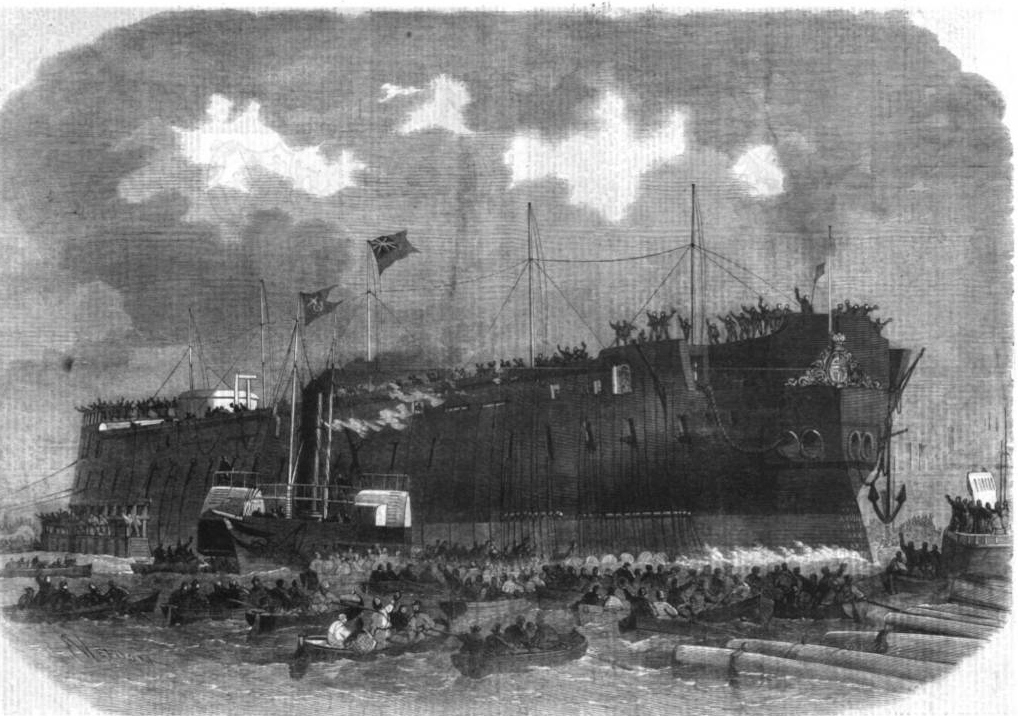
The Northumberland afloat. 1866. [Click on image to enlarge it.]
An unsuccessful attempt to launch the ship

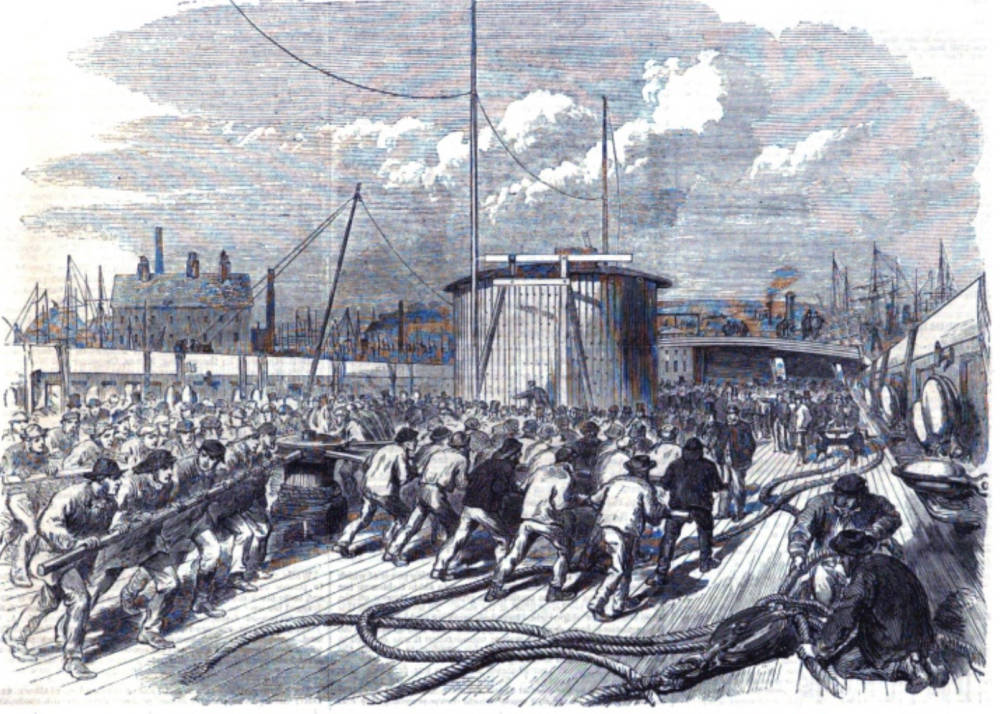
Left: . Right: . [Click on images to enlarge them.]
An unsuccessful attempt was made to launch the Northumberland ironclad, on Saturday afternoon, at the shipbuilding yard of the Millwall Ironworks Company. There was a brilliant and numerous assembly at the hour appointed, two o'clock, and the Prince of Wales, who went down the river from Westminster in one of the river steamers, was one of the spectators. Countess Percy was in attendance to christen the vessel, and among the company were Earl Percy, Sir John Hay, chairman of the Millwall Ironworks Company, Admiral Robinson, Comptroller of the Navy, and other distinguished personages. All the arrangements seemed to be perfect, and when the ceremony was performed the shores were knocked away, and the huge ship commenced what was thought her passage to the river. After having gone about 80 or 100 ft., however, she stood still, to the surprise and regret of every one present. It appeared presently that the obstacle was a serious one, and in spite of the efforts of four tugs she could not be got to move, and the spectators had to separate in disappointment.
A luncheon was given by the company immediately afterwards, in one of the buildings in the yard, to a large party — Sir John Hay presiding. The repast was served in good style by Mr. Webster, of Gracechurch-street. In proposing the health of Countess Percy, coupled with the prosperity of the ship, Sir John Hay stated that the accident was not thought very serious. It had arisen through their precautions against the vessel, from its great weight, having too much way on her. Never before had an attempt been made to launch in the same fashion so much weight, 7000 tons. The Great Eastern was the only heavier vessel, and she was launched in a different way. The Northumberland had almost all her armour-plating on her, but with regard to her sisterships, the Agincourt and Minotaur, one was floated out of dock and the other was launched without the iron plates. Admiral Robinson, in proposing the chairman's health, took a similar view, expressing the hope that the Northumberland would be completely launched in a few days. These opinions were pretty general at the yard, but some fears were also expressed lest the ways had sunk in the forward part when the vessel's weight came upon them.
The Northumberland is an iron-clad screw-frigate of the following dimensions: — Length between perpendiculars, 400 ft.; breadth, 59 ft. 3 1/2 in.; depth of hold, 21 ft. 1 in.; total depth, 42 ft.; burden, in tons, 662l mean draught of water, 25 ft.; engines, nominal horsepower, 1350. She is protected by armour-plates, 5 1/2 in. in thickness, with a teak backing of 9 in and her proposed armament is - on maindeck, four 12-ton 9 in. rifled guns, eighteen 9-ton 8 in. rifled guns; on upper deck, four 6-ton rifled gun?.
During the whole of Saturday night the workmen were busy fixing the most powerful supports under both sides of the vessel, and by Sunday morning she was completely wedged up. At high tide a powerful attempt was made to move her. There was then nearly 24 ft. of water under her stern, and, indeed, she was so much waterborne that many in the yard were positive that she had lifted an inch or two. At this time two enormous hawsers were got across to the building-yards at the opposite side of the river and were attached to powerful capstans, each of which was manned by sixty men. By heaving on these the ropes were drawn almost perfectly straight out of the water, and, at the same time, no less than eleven tugs attached to the Northumberland united all their efforts to pull her off, but in vain; the ship remained absolutely immovable. Even the wedges which supported her on each side showed no signs of having been in the slightest degree affected by the strain upon the vessel. No further efforts will now be made till the return of the spring tides, next Saturday. It is then intended to moor alongside her stern some of the largest lighters which the Admiralty can spare. These will be secured by chains passing under the Northumberland's stern, and it is hoped that with the rise of the tide their buoyancy will be sufficient to lift the after part of the vessel, and so enable her to go off without difficulty. [298]
Success at last
[After previoously relating the failed launch and detailing all the grandees present, Illustrated London News twice described the successful, first repeating preparations for the event and later going into a more detailed description of the process and emphasizing the use of "camels" (pontoons) to help float the enormous vessel.
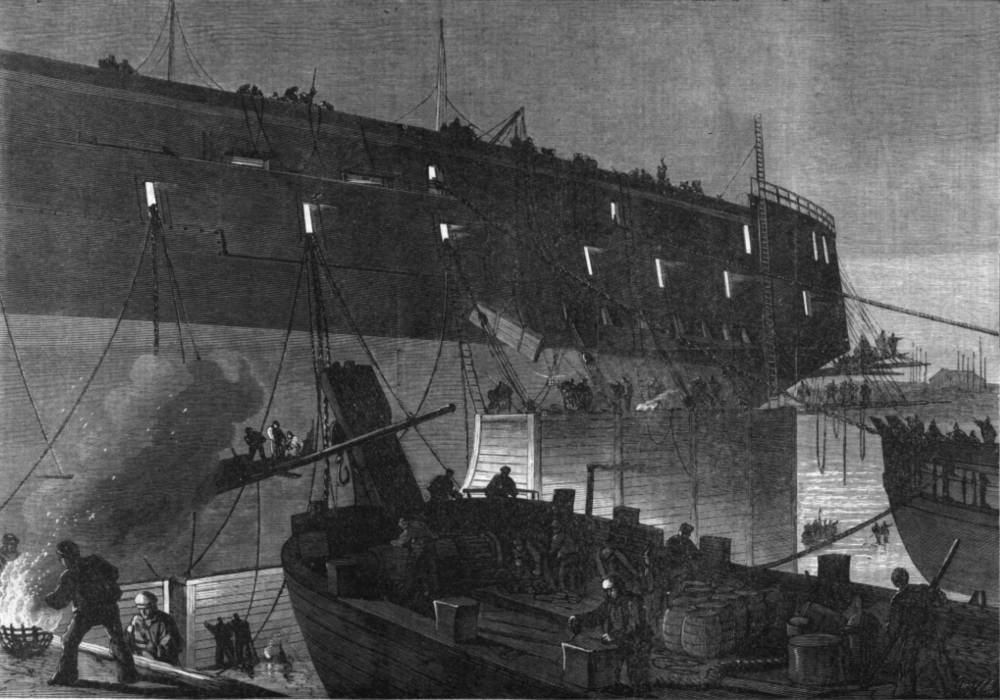
The launch of the Northumberland — Fixing the camels at night.
The Northumberland is afloat at last. The launch was accomplished on Tuesday, in the presence of a numerous and brilliant company. The preparations which had been made for the launch have already been described, but it may not be amiss here briefly to repeat them. The object was to lighten the vessel partly by the stern, and for this purpose four large camels, or pontoons, were attached by means of strong chains, two on each side of the stern of the vessel—the chains passing under the ship's keel. Each of these camels was 50 ft. long, 25 ft. deep, and 20 ft. extreme width. The united lifting power of these four camels was estimated at 2000 tons. In addition to this power there were the si* smaller pontoons previously used, and the other appliances of Bteamtugs, hawsers, and capstans. The Northumberland's ways also during the past week had been taken up and relaid to the extent of about 200 it. at the midship section and bow, and her sliding timbers had been considerably widened, which, it was considered, would keep the ship from hanging should she once start. New foundations and timbers of great strength to support the hydraulic rams were placed under her bows, and the hydraulic pressure was nearly donble that used on the previous occasion—being now 1500 tons. On each side, to work against the bilge logs, were placed two presses, exerting a combined force of 1000 tons on each side, to start the ship down the ways. A number of hogsheads, also, the united floating power of which equalled 100 tons, were lashed under the bows to aid in lightening her there, and relieve, as far as possible, the pressure to be thrown on the forward part by her being lifted at the stem. To accomplish all this large numbers of shipwrights have been working night and day, and the operations have been unceasingly watched throughout by the chiefs of the Admiralty. On mature consideration it was resolved to dispense with the teams of horses on this occasion, as also with the use of derricks to assist in raising her. It was soon evident that whatever advantage was derivable from a good tide would be obtained. Shortly after three o'clock there was nearly 25 ft. under the stern of the Northumberland. Nor was there the disadvantage of the stiff breeze which on the preceding day had occasioned some fears lest it might cause the vessel to swerve round too suddenlv should she encounter in launching such a blast as then blew. Shortly before three the clang of immediate preparation was heard, and speculation was rife as to whether the Northumberland would take the water. At last the shores were knocked away and the blocks removed. Then the signal was given for the driving ont of the dogshores, and the ship, gliding grandly down the ways, safely, and without accident to anyone, on the river. Need it be said that there was great cheering, that music was heard, and that congratulations passed everywhere?
While the yard's people were shooting hither and thither in boats, to pounce upon any fragment of timber that might be escaping to sea, some black little tugs took the Northumberland into custody and dragged her over to her moorings, where she was soon secured, with her bows towards Greenwich Hospital. We give two Engravings relating to the launch of the Northumberland. One, on page 377, represents the busy scene on deck preparatory to launching; and another, on page 380, the fixing of the camels around the stern of the ship at night. division of
The second article on the launch
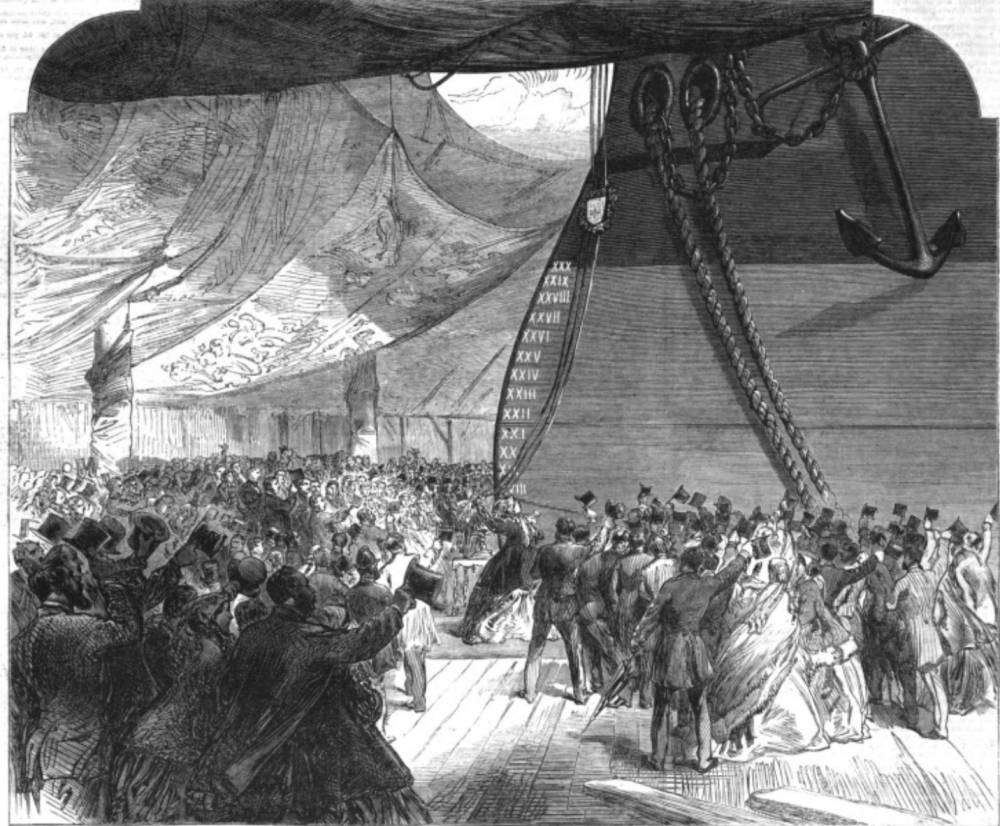
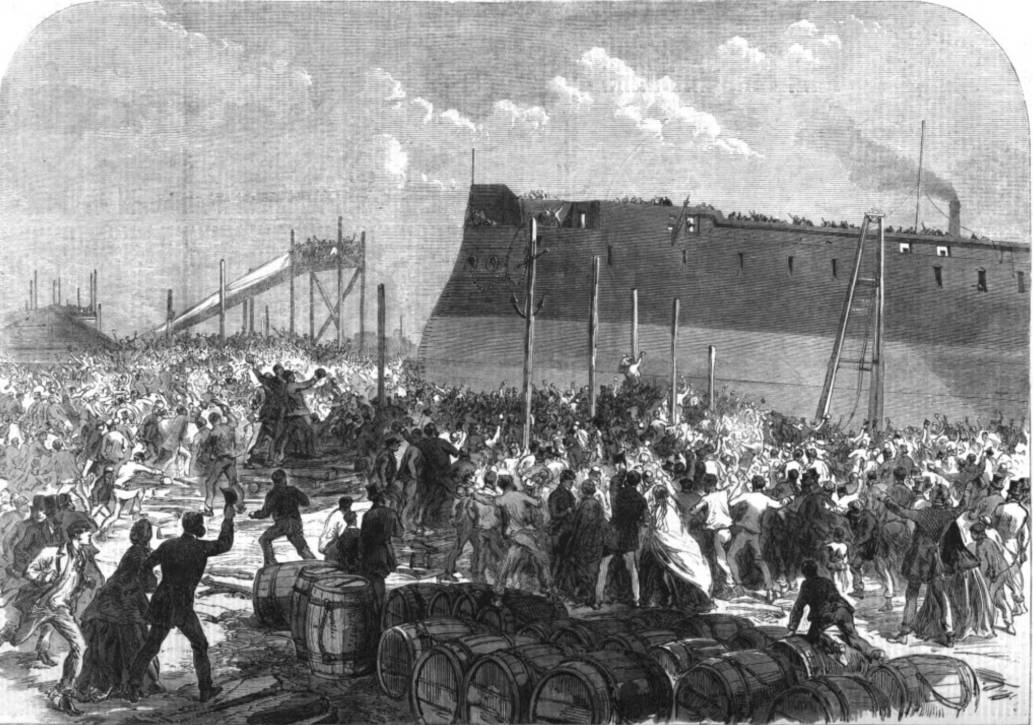
Left: Countess Percy naming the new ironclad ship Northumberland, at Millwall. Right: Our ironclad fleet: The launch of the Northumberland — “She’s off!”.
To the Engravings which we have already given in relation to the launch of the Northumberland we add, in the present Number, two others illustrative of the auspicious event—one depicting the huge vessel sliding down the ways and the other showing her afloat [at top of page abiove]. Seven hydraulic presses were needed to push the cradle down and to lift the fore part of the vessel. Three of these — one of 1000 and two of 400 tons pressure — were placed beneath the keel, so as to assist in lifting the huge hull forward and relieve the weight where it most bore upon the launching-ways. Four other hydraulic rams were fixed, with iron backings, so as to thrust against the cradle and force it down the incline which led to the river. Two were of 600 tons power each and two of 400 tons, giving an aggregate of 1800 tons upward lift and 2000 tons downward pressure towards the water. Two smaller rams, however, under the forefoot of the vessel were not much used in getting her off, and were meant simply to supply the place of the common wooden blocks generally used on these occasions.
The chief means employed were two constructions technically called "camels." These were enormous boxes, of such a shape as to fit completely under the stern of the vessel, and so to exert an immense buoying power as the tide rose. Considerable difficulty was experienced in getting these camels safely fastened under the Northumberland's quarter. It was not till the morning of Tuesday week, the day of launching, that they were all perfectly secured. The draught of water of these immense buoys is only 4 ft.: and, as they had to be kept down at a depth of 22 ft., the difficulty of restraining their buoyancy was very great. It was eventually accomplished by chains fixed at low water, and by huge timber struts, which, fastened to the vessel's side and wedged into the shore, at last kept them in their proper positions. The floating power which these and the other smaller camels and lines of empty barrels gave was equal altogether to about 1600 tons. The vessel itself, when immersed at high tide, would, it was calculated, be reduced in its weight npon the ways by about 4000 tons more; so that literally no greater weight than 2000 tons would remain to be started, to effect which the hydraulic power was much more than equal. Indeed, as the tide rose, on Tuesday afternoon, the general fear was that the ship would be too lively and get afloat before the state of the tide would allow of her being safely turned out into the river. The sluices in the aftermost camels were accordingly opened to let in the water and decrease their buoyancy; yet, in spite of these and other precautions, the vessel did, after all, go slowly, but so far suddenly that there was not sufficient time to ease off the chain-cables which moored her with anchors to the ground, until the latter had been torn from their positions.
Both tide and wind were unfavourable to the attempt, but before two o'clock the ship showed such unmistakable signs of yielding to the enormous powers of flotation which had been placed under her that it was unanimously decided to continue the launch. Mr. Langley, the general manager of the Mill wall Works; Mr. Luke, the Admiralty superintendent at Deptford; and Mr. Bascombe, the Admiralty surveyor, who have all worked day and night to get the ship off, were in favour of an immediate attempt being made, and accordingly all the men in the yard, the seamen riggers and marines who had been lent by Government from Deptford, were told off to their respective stations at the dogshores, the hydraulic presses, the camels, and the moorings. Shortly after two o'clock the vessel began to lift visibly by the stern, and by half-past two she had risen 7 in. off the launching-ways aft, and nearly 1 in. under the cradle forward, where she is now known to have "nipped." Every movement, even to the eighth of inch, was written down, and sent to Sir John Hay, the of the company, who was, with a number of nautical engineers, superintending, with Mr. Langley and Mr. Luke, the operations at the bows. Soon after half-past two the vessel began to move slightly, but still perceptibly, down the ways, and in the course of a few minutes had glided more than an inch and a half, and so jammed the struts which had kept her upright that it was with great difficulty they could be moved. In spite of these indications of her liveliness, however, it was wisely determined not to give the signal for working the rams till the river was clear and all else in readiness. Such an opportunity did not occur till close on three o'clock, when the men were set to work at the hydraulic presses. There were a few minutes of intense anxiety as the gangs heaved at the pumps, and the huge crowds assembled in all directions kept cheering. Then the vessel at last moved, and as she did so she drew the anchors which moored her to the earth, the chain cables were let go by the run, and, as they went with a thundering rattle out of the hawseholes, the Northumberland, amid cries of "She's off!" and loud cheers, glided slowly, but with perfect ease and regularity of motion, into the river.
It is almost impossible adequately to describe the enthusiasm with which her going off was greeted. There had been so many fears both of accident to the ship and those engaged in getting her afloat, that it seemed ss if the joy both of the workmen and spectators was almost boundless at beholding her safely afloat in the water without accident of any kind. The instant she got into the stream the tide took her up the river, and, though half a dozen powerful tugs at once grappled with her and tried to tow her down, they were for a time powerless, and it seemed as if, after all, the Northumberland would go ashore. Fortunately, the high wind, setting against the tide, aided the efforts of the steamers, and in the course of about half an hour the ponderous hull was brought to the moorings laid down for her, where a deep hole had been dredged in the river bed for her accommodation. Yesterday week the Northumberland was towed by six tugs into the Victoria Docks, for the purpose of being completed for sea. Her engines, of 1850-horse power, by Messrs. Fenn and Sons, are finished. [426]
You may use this image without prior permission for any scholarly or educational purpose as long as you (1) credit the Hathi Trust Digital Library and The University of Michigan Library and (2) link your document to this URL in a web document or cite the Victorian Web in a print one. — George P. Landow
Bibliography
[All the following have been read in Hathi Trust Digital Library versions of a copy or copies in the University of Michigan Library. Web. 16 January 2016.]
“The Ironclad Northumberland.” Illustrated London News 48 (24 March 1866): 297-98.
“The Launch of the Northumberland.” Illustrated London News 48 (21 and 28 April 1866): 376-77, 424-26.
Last modified 15 January 2016